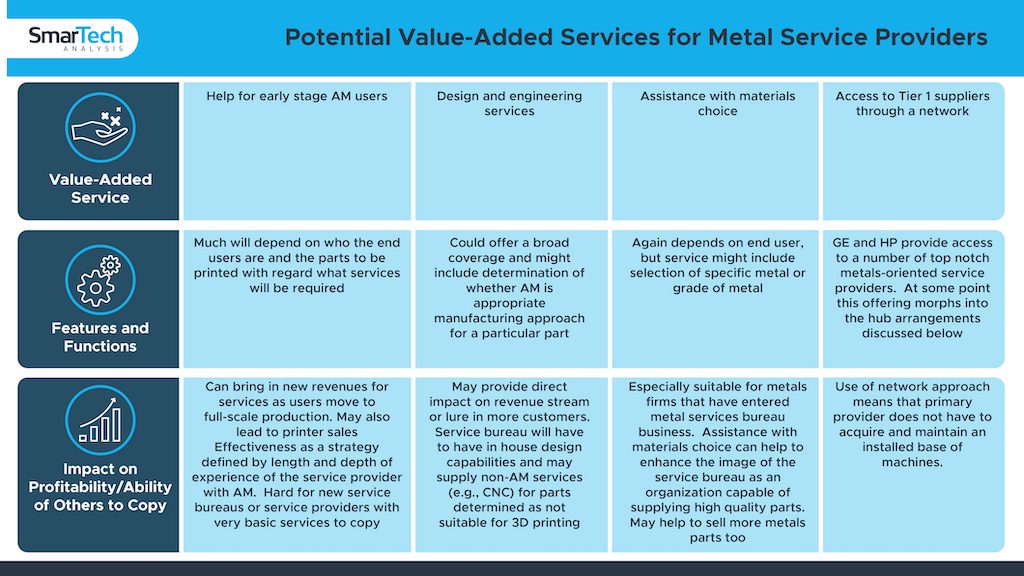Additive manufacturing of metal is popular, but some end user companies are reticent about in-house printing of metals parts. This is, we believe, a powerful factor creating opportunities for metal AM service bureaus. This article defines five factors that have some service bureaus planning for a doubling the number of metal machines this year (2019) according to SmarTech.
#1 Metals Printing Can be Trouble
In the future service bureaus are likely to lose business to in-house 3D printer deployments for polymer printing, but their metals business may increase. Additive manufacturing with polymers is more user-friendly than metals printing making the capital and expertise easier for end users to move the process in-house. There are more process parameters and knowledge involved with metal printing. And, on the materials side, new metals may require special techniques and expertise that are not easily or quickly achieved in-house. This “tribal” knowledge will help service bureaus keep their competitive advantage longer as metal AM becomes more cost-effective and user-friendly.
Metal 3D printers will reduce in cost in the next few years – we have already seen how this could happen from the latest HP and Desktop Metal products. Nonetheless, SmarTech Analysis believes that the combination service provider knowledge, supply chain efficiencies, and high-capital cost will keep metal service bureaus competitive for the foreseeable future.

#2 The “Hot Topic Effect”
The current high level of publicity being afforded to metal printing automatically enhances the prospects for metal service bureaus. Hot topics are, by definition, of immediate importance, but they tend to cool down relatively quickly. It is to be expected that metal additive manufacturing will eventually become less hot as it matures and becomes just another process in the engineering toolbox. Yet, less attention doesn’t necessarily mean that market growth would stop, just that investors’ enthusiasm might shrink.
#3 Lack of User Capital and Low ROI
A classic driver for companies to not 3D print in-house is that some companies just don’t have the capital. The impact of this market driver in metal AM is likely to intensify in the future as more end-user firms find they have a need for metal AM but cannot justify the capex.
Service bureaus also offer a way for companies to dip their toes in the AM metals business without having to invest heavily in the equipment, expertise, or time associated with bringing the process in-house. Some companies may even have the capital, but due to fluctuations and volumes the return on investment (ROI) of in-house metal AM is too low to make it viable. Offering metal 3D printing won’t tie down a service bureau, and a company can test the market to verify a parts value before investing the capital to move production in-house.

#4 Size, Complexity and Service Bureaus
Service bureaus may be able to handle large and complex parts more effectively and efficiently than in-house printing can. Being able to process large parts will give a service bureau additional value. Bringing metal printing in-house is already difficult enough, adding larger more expensive equipment adds complexity.
Finally, understanding different materials, process capabilities, and how complex features can change a design will be the experience service bureaus should have that will prevent or delay companies from moving in-house. Simple design concepts, post processing, and even part orientation can help produce a better product.
#5 Industry Focus Helps
Expertise in a particular industry provides a competitive advantage for service bureaus. It enables a service bureau to better understand its customers and for both customers and service bureaus to interact in a more effective way. As a result, some service bureaus are specializing in customers from the aerospace industry or the medical sector. Specialized automotive service bureaus are also expected to appear in the near future.
These comments apply to polymer AM as well as metals AM, but we note that specialist aerospace and automotive bureaus both have a strong metals orientation. Metals service bureaus that understand the needs, operations and traditions of big metal-using industry sectors are in a better position to win customers than those who don’t.
For more on the topic of AM metals service providers see “Metal 3D Printing Services: Service Revenues, Printer Purchases, and Materials Consumption – 2018-2027,” one of SmarTech’s latest reports. Metal 3D printing is disrupting multiple industries and service providers with a focus on metals will have the opportunities to take advantage of the technology.
Subscribe to Our Email Newsletter
Stay up-to-date on all the latest news from the 3D printing industry and receive information and offers from third party vendors.
Print Services
Upload your 3D Models and get them printed quickly and efficiently.
You May Also Like
Consolidation in AM: How 2025 Is Shaping the Industry’s New Normal
The first half of 2025 has been marked by a clear shift in the additive manufacturing (AM) industry. Companies are no longer just focused on developing new tech by themselves....
Etsy Design Rule Change Reduces Selection of 3D Printed Goods
Online marketplace Etsy has implemented a rule change requiring all 3D printed goods on the site to be original designs. The update to the site’s Creativity Standards states, ¨Items produced using...
U.S. Congress Calls Out 3D Printing in Proposal for Commercial Reserve Manufacturing Network
Last week, the U.S. House of Representatives’ Appropriations Committee moved the FY 2026 defense bill forward to the House floor. Included in the legislation is a $131 million proposal for...
Transforming From Tourist to Native: Duro CEO Michael Corr Explains Why the Company Rebuilt its PLM Software on AI
In these early innings of the AI boom, many market analysts have expressed concern that AI spend has gotten too far ahead of the technology’s proven ability to deliver significant...
































